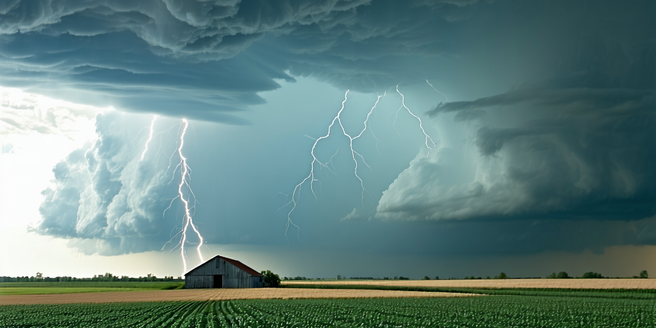
Understanding the Formation of Thunderstorms
Thunderstorms are born from the unstable atmosphere where warm moist air rises rapidly into the cooler layers. This creates cumulus clouds which can develop into larger cumulonimbus clouds, signaling a mature thunderstorm. These storms can be mesmerizing to watch, with their dynamic and ever-changing nature. Lightning is one of the most striking features of these powerful storms. The key components are moisture, warm air, and lift, which fuel the convection process. As the air continues to rise, it cools and condenses, releasing latent heat. This heat accelerates the rising, forming an updraft and further enhancing storm development. The mature phase is characterized by strong winds, lightning, heavy rain, and sometimes hail, all symptoms of the intense energy processes underway.
The Mechanics of Tornado Development
Tornadoes emerge from supercell thunderstorms, which are characterized by a rotating updraft known as a mesocyclone. The process begins with wind shear causing the air to spin horizontally. Scientists are continually researching to improve predictive models of tornado behavior. As the updraft intensifies, it tilts this rotating air vertically, stretching and tightening it into a tornado. Meteorologists closely monitor these developments to issue timely warnings and save lives. The interaction of varying wind speeds and directions at different altitudes plays a crucial role. A distinct rear-flank downdraft can also contribute to tornado formation by enhancing the rotation and funnel. Tornado strength can vary widely, measured by the Enhanced Fujita scale, determined by the damage inflicted.
Warning Signs of Tornado-Triggering Storms
Recognizing the early signs of potential tornado formation is critical for safety. One of the main indicators is the presence of strong, persistent rotation in a cloud. A low-hanging wall cloud, visible beneath a rain-free base, is often a precursor. Additionally, sudden darkening of the sky, a greenish hue, and large hail are strong signals. It’s important for communities to have emergency plans in place to respond swiftly. In some cases, the air may feel unusually still before a tornado strikes. The sound of a freight train, often described as a roar, is another alarming sign. Meteorologists use Doppler radar to track these indicators, issuing warnings when conditions suggest a tornado is imminent. Public awareness and understanding are vital components of preparedness.
Impact of Tornadoes on Affected Regions
The aftermath of a tornado can be devastating, affecting communities both physically and economically. Tornadoes lead to loss of life, injuries, and significant property damage. Infrastructure such as roads, power lines, and buildings can be destroyed, disrupting daily life and causing financial burdens. In the wake of such destruction, communities often come together to support each other and begin the rebuilding process. During this time, volunteers and local organizations play a crucial role in providing immediate assistance and resources. Agricultural areas suffer as crops and livestock may be lost. Recovery efforts require substantial resources and time, often relying on aid and community support. The psychological impact on affected individuals and communities is profound, with many facing anxiety and trauma long after the storm has passed.
Safety Measures During Tornado-Prone Thunderstorms
During tornado-prone conditions, having a safety plan is essential. Identify a safe room or storm shelter in your home, ideally a basement or an interior room on the lowest floor. Ensure that all family members are familiar with the plan and know the designated safe area. Practice regular drills to reinforce these safety measures. Avoid windows to prevent injury from shattered glass. Keep a climate radio for updates and alerts. Assemble an emergency kit with essentials like water, non-perishable food, flashlight, batteries, and medications. If caught outdoors or in a vehicle, seek shelter immediately; do not try to outrun a tornado. Community awareness and preparedness drills can help improve response times and reduce risk during such extreme weather events.
